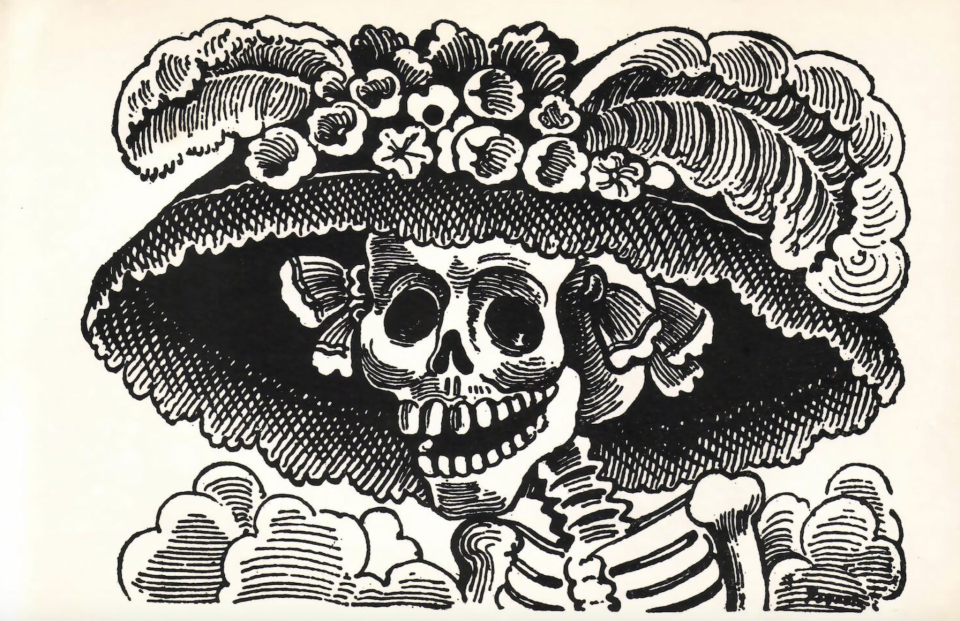This Is What You Need to Know Before Doing Sugar Skull Makeup on Halloween

Elizabeth Fernandez, Getty Images
Día de los Muertos, aka Day of the Dead, is a two-day Mexican holiday that honors families' deceased ancestors through various traditions. Typically, family members will set up an altar with photos of those departed with ofrendas (offerings), which are gifts for those who passed. "We put up an altar with the pictures of our loved ones that passed away, and add a few of their favorite things like baked goods, their favorite drinks or treats, and marigold flowers," says Yasmin Maya, founder of Birdy Lashes and Beauty. "We'll usually come together in prayer, eat pan de muerto, and that same night we'll light candles to help guide our loved one's souls for their visit."
In addition to the ofrendas, people throughout the cities of Mexico will paint their faces in sugar skull makeup and dress up in colorful dresses with floral prints and designs during the parades. Between the dressing up, painting of faces, and proximity to America's Halloween date, many people from other countries refer to Día de los Muertos as the "Mexican Halloween" and have adopted sugar skull makeup as a popular Halloween costume.
However, the holiday represents the furthest thing from Halloween. The sugar skull makeup worn on Día de los Muertos is a time-honored symbol that represents and celebrates those who have passed. Unlike Halloween, which is a holiday to dress up in scary costumes, Día de los Muertos is a colorful celebration to honor your deceased loved ones. It's these critical differences that make us question whether doing sugar skull makeup for Halloween is appropriate or problematic. To answer that, it's important to learn the history of skull makeup and the culture that started it all.
What is sugar skull makeup?
Sugar skull makeup comes from a famous drawing known as La Catrina. La Catrina is a female skeleton wearing a fancy feathered hat, similar to the one that wealthy Europeans wore in the 1900s—it was created by political cartoonist and artist José Guadalupe Posada. Posada originally drew La Catrina as a satirical message that said no matter your race, class, or background, we're all going to die someday. Since the creation of the drawing, La Catrina has become one of the most recognizable symbols of Día de los Muertos.
As previously mentioned, many people dress up in colorful gowns and do skull makeup during the holiday as a nod to the famous drawing and to celebrate deceased ancestors. Regina Merson, the founder of Reina Rebelde, says she looks forward to doing her Catrina makeup every year. "I find the ritual of constructing my Día de los Muertos altar to be very therapeutic albeit a bit sad, so I love balancing that ritual with the ritual of my Catrina makeup, which is part of the more celebratory aspect of the holiday."
There's been growing popularity and knowledge of these traditions, especially after the release of the animated movie Coco, which came out in 2017. With that popularity, sugar skull makeup has become a "trending" Halloween costume created by those who aren't Mexican. One search of #sugarskullmakeup on Instagram will garner hundreds of thousands of results, and the makeup video tutorials on YouTube are endless. But, is doing sugar skull makeup on Halloween watering down the importance and significance of the makeup and holiday?

The Grace Museum, Jose Guadalupe Posada
Is sugar skull makeup cultural appropriation?
It doesn't have to be, but the answer will differ depending on who you ask. Both Merson and Maya ultimately feel that recreating skull makeup doesn't need to be strictly for Mexican people, but both agree that there is a fine line between appropriation and appreciation.
"One of the most offensive things is when people paint a Catrina and make the look intersect with something scary and bloody," says Merson. "Remember, La Catrina represents your dead relative, not a scary Halloween character." She explains that intention is key when doing this makeup. "Everyone can relate to the experience of losing someone and trying to connect with them in the afterlife, so as long as people take the time to understand its rituals and meaning, I think it's great for anyone to participate."
Maya feels similarly, saying it didn't start to rub her the wrong way until she realized people were forgetting or failing to mention why sugar skull makeup is done in the first place. "To me, it seemed like it wasn't being respected or honored the way it should be," she says. She noticed people weren't giving credit to the holiday or using it to their advantage for monetary purposes. "I think anyone can do sugar skull makeup, but they must honor the holiday and understand the meaning behind it," she says.
Should you do sugar skull makeup for Halloween?
If you're thinking of doing this makeup on Halloween this year, make sure you're fully knowledgeable about the origins of the ritual. "I always love the idea of people from all cultures participating in this ritual as long as its history is understood and the process is respected," says Merson. Another appropriate way to do this makeup look is if you're using it as an opportunity to educate others about the history of sugar skulls and Día de los Muertos, says Maya.
Ultimately, to do sugar skull makeup respectfully takes true understanding and appreciation of the holiday and culture. Merson says, "the sugar skull is meant to be the physical representation of the human world connecting with the spiritual world, so you want to give it the care, love, and attention because it represents the souls of our loved ones."

 Yahoo Movies
Yahoo Movies 
